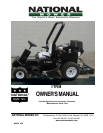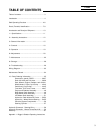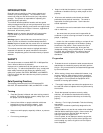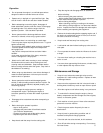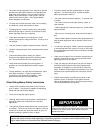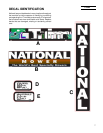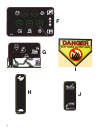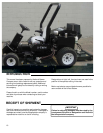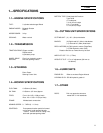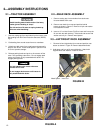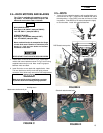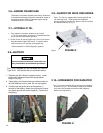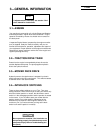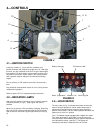
I-TRIM
®
5
Operation
• Do not operate the engine in a confined space where
dangerous carbon monoxide fumes can collect.
• Operate only in daylight or in good artificial light. Stay
alert for holes in the terrain and other hidden hazards.
• Before attempting to start the engine, disengage all
blade attachment clutches, shift into neutral, and engage
the parking brake. Only start the engine from the
operator’s position. Use seat belts if provided.
• Never operate with the discharge deflector raised,
removed, or altered, unless using a grass catcher.
• Remember there is no such thing as a safe slope.
Travel on grass slopes requires particular care. To guard
against overturning:
- do not stop or start suddenly when going up or downhill.
- machine speeds should be kept low on slopes and
during tight turns.
- stay alert for humps and hollows and other hidden
hazards.
- never mow across the face of the slope, unless the
mower is designed for this purpose.
• Watch out for traffic when crossing or near roadways.
Slow down and use caution when making turns and
crossing roads and sidewalks. Stop the blade rotation
before crossing surfaces other than grass. Stop reels or
deck blades if not mowing.
• When using any attachments, never direct discharge of
material toward bystanders or allow anyone near the
machine while in operation.
• Never operate the machine with damaged guards,
shields, or without safety protective devices in place. Be
sure all interlocks are attached, adjusted properly, and
functioning properly.
• Do not change the engine governor settings or
overspeed the engine. Operating the engine at
excessive speed may increase the hazard of personal
injury.
• Disengage drive to attachements when transporting or
not in use.
• Before leaving the operator’s position:
- stop on level ground;
- disengage the power take-off and blade rotation
and lower the attachments;
- Change into neutral and set the parking brake;
- stop the engine and remove the key.
• Keep hands and feet away from the cutting units.
• Stop the engine and disengage drive to attachment
- before refuelling;
- before removing the grass catchers;
- before making height adjustment unless adjustment
can be made from the operator’s position.
- before clearing blockages;
- before checking, cleaning or working on the mower;
- after striking a foreign opject or if an abnormal vibration
occurs. Inspect the mower for damage and make repairs
before restarting and operating the equipment.
• Reduce the throttle setting before stopping engine and, if
the engine is provided with a shut-off valve, turn the fuel
off at the conclusion of mowing.
• Keep hands and feet away from cutting units.
• Look behind and down before backing up to be sure of a
clear path.
• Do not operate the mower under the influence of alcohol
or drugs.
• Use care when loading or unloading the machine into a
trailer or truck.
• Use care when approaching blind corners, shrubs, trees,
or other objects that may obscure vision.
Maintenance and Storage
• Keep all nuts, bolts and screws tight to be sure the
equipment is in safe working condition. Replace all worn
or damaged decals.
• Never store the equipment with fuel in the tank inside a
building where fumes may reach an open flame or spark.
• Allow the engine to cool before storing in any enclosure.
• To reduct the fire hazard, keep the engine, silencer,
battery compartment and fuel storage area free of grass,
leaves, or excessive grease.
• Park machine on level ground. Never allow untrained
personnel to service machine.
• Check the grass catcher frequently for wear or
deterioration.
• Keep all parts in good working condition and all
hardware and hydraulic fittings tightened.
• If the fuel tank has to be drained, do this outdoors.
• Shut off fuel while storing or transporting. Do not store
fuel near flames.



